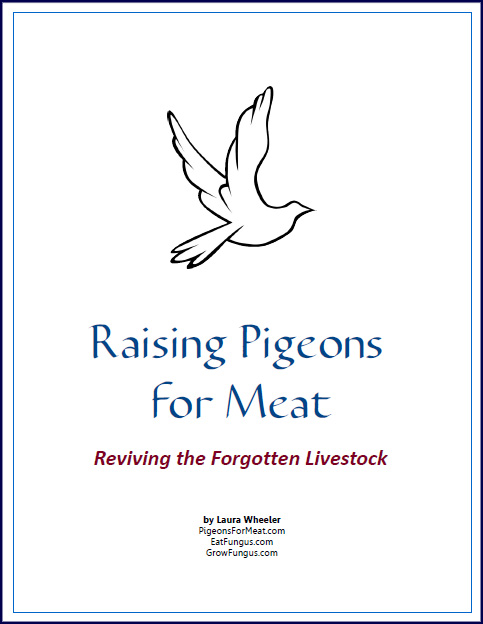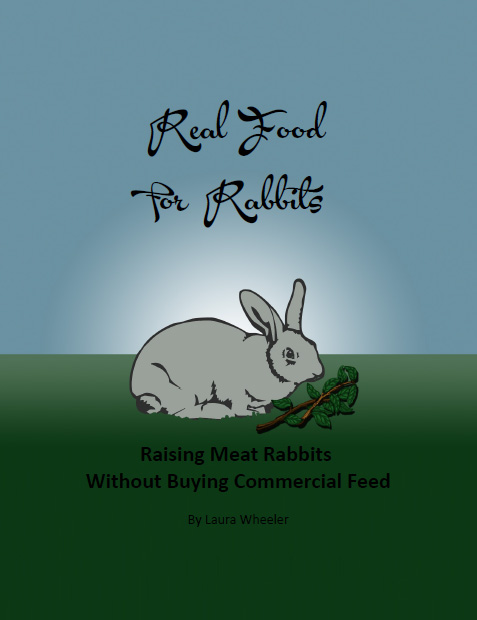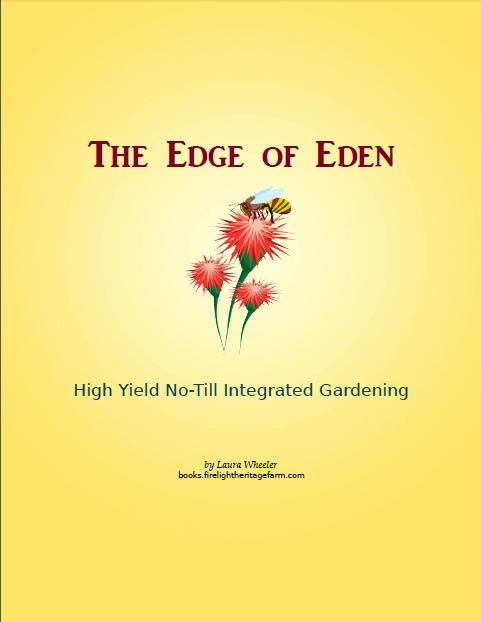Ok, so I get fileted every time I post regarding weeds right now, because I have an attitude about this.
PLEASE do not post advising people to eat weeds unless you are experienced with this, because there is a REALITY that goes along with these, that you are probably unprepared for. If they were THAT good, they'd be mainstream.
1. Alfalfa - Flavorless, except the blossoms. Has elements in it that can affect hormones and blood clotting (encourages blood clots) that can be seriously damaging to some people. It is used medicinally, and with good effect, but it is not a pleasant food, overall. If you are desperate, you can eat it, but it isn't really enjoyable.
2. Borage. Flowers can be eaten. The rest is too tough and fuzzy to want to eat, and you aren't going to get enough of the flowers to make any kind of nutritional difference in your meal. This is also a medicinal herb, and has oils that help balance neurotransmitters in the brain, and which encourage nerve health, skin, hair, and nail health. But it isn't usually found wild, usually it is grown in gardens.
3. Cattail shoots are edible, but difficult to harvest. For some people, DANGEROUS to harvest, they grow in marshy areas around the edges of ponds and lakes, so it is not a place you can easily get to. This refers to "roots, shoots, or stalks" according to various authors. Traditionally, it is SHOOTS, only. The very young early shoots, that are barely beginning to leaf out in the spring and summer. There are three problems with cattails, which is why nobody sells them commercially, not even at the odd farmer's market. The first is that they are HARD to get at. They grow in MUD, and you can't walk out to get them, except maybe one or two on the edges. They do tend to love embankments that drop suddenly into water, and they want to grow with their feet in very wet mud. If you try a boat, the same thing is true, you can only get one or two on the edges, before you run around into the mud. They are reputedly difficult to pull. People DIE trying to harvest these if they are not careful. The second problem is that they are pretty rough. Somewhat tough and fiberous at their best. A little like overgrown bamboo shoots. This makes the tedious to cut up, and slow to chew even when cooked well. The third problem is that they don't even taste good. They have an off putting flavor, and you won't want to eat them unless you are are really starving. I have not tried them, but chose NOT to, based on both the information I received from people who had (who were honest about it), and the general unavailability of them.
4. Yarrow. Nobody eats Yarrow, even when they are desperate. It tastes harshly medicinal. It is a medicinal herb, not a food herb, and even then, we do not use it as tea unless we have to, we prefer to swallow it WITHOUT having to taste it. It ranks somewhere near #4 in the list of worst tasting herbs of all time (beat out only by Hops, Bacopa, and Horehound - this list is still in progress, I'm sure there are many more horrific wonders still awaiting discovery).
5. Dandelion. Sometimes sold in specialty salad mixes, but never quite makes it mainstream, because it is bitter, and degrades more quickly than producers like. Also considered a medicinal herb, but the lore regarding it is NOT accurate, it is really only good for minor healing benefits and it is high in iron. It is not a magical herb.
6. Echinacea. The petals are sometimes eaten on salads, but really, it is NOT a tasty herb, and in fact ranks #5 on the list of worst tasting herbs. It is highly antibiotic (NOT antiviral, and yes, I've tested this, and used it in part of a Strep treatment), and one of the most epically nasty flavored herbs (right up there with Yarrow, Hops, Fernbush, Bacopa, Horehound).
7. Garlic Mustard. Never tried this one. But mustards on the whole are pungent, bitter, and somewhat harsh on the digestive system if you eat them raw (though they TASTE better raw). Oddly enough, this one does not grow near me, so I can't try it out. Considered to be a good edible by many sources though. Take it with a grain of salt, but by all means, try it. People I know recommend serving it cooked with onion to tone down the mustard bitterness.
8. Milkweed. Can't imagine eating this one. Tough, and milkweeds are invariably bitter. The leaves just don't act like spinach or Lamb's Quarter, they stay somewhat leathery. But again, I've not tried this one.
9. Purslane. Love this stuff, but it grows slowly, and it is VERY HARD to get enough of it to do more than decorate a salad with the leaves. Do that though, if you can find a healthy patch, because it is really delicious. We don't cook it, it goes all slimy.
10. Wild Bee Balm. Petals considered to be tasty, leaves rather pathetic and tough. I have not tried this one, I do not have access to it, so I am relying on the word of people who have tried it.
11. Sorrel - Wood Sorrel (looks like a three leaf clover on a single stem and tastes tart), and French Sorrel (look it up), are both tart and tangy, delicious, but you can't eat much of them. I grew up nibbling on these in the woods where we lived, and they do taste good in a salad.
12. Wild Garlic. Grows straight up, with tube like leaves. Smells and tastes like garlic, but has a mild element to it. Tops can be cut for easy use. Bulbs are buried so deep, and are so skinny, it is really hard to dig and clean enough for much use.
13. Wild Onion. Many kinds, most flat leaved, no tube leaves. Very oniony, the leaves are great to cut, snip up, and add to sauteed greens. I grow and use this, it is kinda fun.
14. Other Mustards. Blue Mustard is so small it is hard to get enough of it unless it is in a well watered area. Rough Mustard and Common Mustard are easy enough to harvest and use, but very bitter in flavor. Tansy Mustard is not worth the bother unless you are starving, because it is tough, feathery, and very bitter.
15. Mares Tail. Bland, somewhat tough, with a rough surface texture. I'd eat it again, but only if really hungry. There's just better food available.
16. Dead Nettle. Purple Dead-Nettle, and Spotted Dead-Nettle, and Common Dead-Nettle are all edible. Square stemmed with SQUARED pointed leaves. Fuzzy foliage, which is just unpleasant raw, and so-so cooked. But I'd eat this one, or put it in a smoothie if I were really hungry. Some people make a big deal out of the blossoms being tasty and edible, but really they are so small you can't get enough to even taste them, but they do look pretty sprinkled on a salad.
17. Henbit. Often confused with Dead-Nettle, and part of the same plant family. Square stemmed with ROUND scalloped leaves. A fairly good pot herb, works well to sautee it with a little garlic salt. Did not enjoy it raw.
18. Wild Parsnip. This is a skinny and generally woody parsnip with a feathery carrot top. Don't bother with it. WARNING! Picking this WILL give you a nasty rash, sometimes even through clothing, and the rash itches and burns, and gets worse with sun exposure on it. There's so much confusing info on identifying it that you will never be sure unless someone pulls it and shows you, and even then...
19. Oregon Grape. The berries are listed as toxic, but they are not. They are just HIGH in oxylates, and that means they are SOUR. It does not mean you cannot consume them, but you MUST dilute them down. They are used for a diluted jelly. The leaves are medicinal, and quite effective in buffering Olive Leaf and Black Walnut Hull.
20. Elm Seed. Pretty much any elm, but I've used Siberian Elm. The seeds are a small winged petal with a seed on one side. They are edible, and sometimes sprinkled on salads. I've made a nut butter from them, but it was strange, don't bother. These are loved by chickens and rabbits, and are easy to strip from the limbs into a bucket, and you can just HEAP them into your food dehydrator and they dry overnight. They are also antibiotic, and can be used for tea or to grind in the blender and encapsulate for herbal use. Who knew?
21. Plantain. Broad and Narrow Leaf. This is a tasty pot herb, broad leaf is best. It is good when boiled or sauteed, is too chewy raw. But you really CAN'T gather enough to even make a side dish. That whole "white man's foot" thing is made up, there is no truth in it, Plantain does not grow prolifically, and only grows in areas that are regularly disrupted, or very poor ground, and has never been a viable crop, it just does not cultivate thickly. It has absolutely NO medicinal value as anything other than a buffer for harsher herbs.
22. Morning Glory. Leaves are edible, but sometimes tough. Some are tender, mild flavored, and delicious when cooked with butter and salt. Pick the soft floppy vine ends with the new leaves on them. Pick a LOT, it wilts down just like spinach does, but has a better flavor. This one is just so tasty, but HARD to gather enough for a side dish.
23. Lamb's Quarters or Goosefoot. Used mostly as a pot herb, cook with butter and salt, or garlic. A bit too soft and mushy for me, but tastes good.
24. Wild Amaranth. Tough and chewy, but can be dried, crushed, and added to soups.
25. Dewberries. Little tiny low growing blackberry vines with miniature blackberries. Sweet and delicious when ripe. Very hard to gather enough for more than tramping nibbles.
26. Red Huckleberries. Bush that often grows on deadwood, blueberry-like leaves, and small red berries that have a blueberry type form. Tart fruity flavor. HARD to gather enough to do anything with, the bushes are scattered, and the berries not heavy on them. My sister once persuaded us to pick enough for jam, and it was very cranberry-like in flavor, but that took a LOT of effort from the whole family to make just a single small batch of jam.
27. Salmon Berry. Grows on a Raspberry type plant that is very large, with large leaves. Berry is formed like a large blackberry, and is yellow orange, sour, with somewhat bitter after notes. Has a peculiar flavor, NOT like a blackberry or raspberry, but entirely unique. If you ever taste it, you won't forget it.
28. Salal. Low bush with medium leathery leaves. Berries grow in smallish clusters, and are blue, somewhat leathery, bland, and have a peculiar flavor that is not unpleasant. We don't know what this flavor is good for, but the berries can sprinkled on a salad and are not unenjoyable. Berries are medicinally healing.
29. Grass Stems. Pull long grass stems apart, and they will have a soft and tender end just below a knuckle, or sometimes without the knuckle. It is sweet and green flavored. Not good for more than nibbles on walkies, but fun to taste. THIS is the meaning of the old pictures of the farmer in his straw hat with a hay stalk in his mouth.
30. Cleavers. Rough and sticky to handle. Kind of rough even when cooked, but has a nice very green flavor. I would not eat this unless desperate, the roughness is really unpleasant in your mouth.
31. Chickweed. How could I forget chickweed? The most delicious salad green EVER. This would be sold commercially if it stored well, but it does not. Brightly green flavored, and so good mixed with salad greens. HARD to get enough to make an entire salad, and you'll never have enough of it in season to satisfy you, but well worth going after if you have it. Does NOT dry well for FOOD use, but is available dried for herbal use.
32. Wapato. Also known as Arrowleaf, it forms a tuber on the roots that accounts for the other name of Swamp Potato. American Indians reputedly waded the shallow swamps and foraged for these with their feet, since they grow in water that is a few feet deep. This makes harvesting wapato fairly risky if you try this method, most accessible bodies of water have broken glass or trash in the mud on the bottom. They are also harvested using a potato rake, but they are so small it is hard to get them out with this tool (they fall between the forks). That said, those who have tried them (I have not), tell me they are good food. They are bland and almost flavorless, somewhat fiberous, and most similar to a Jerusalem Artichoke. I am told they can be chunked and fried crispy, in bacon grease, for a satisfying side dish. They are so problematic to harvest that most foragers now do not even know they exist.
WARNING!! WARNING!! The plant that is now promoted online as Common Mallow is NOT a Mallow plant, It is Lady's Mantle, and it is DANGEROUSLY Poisonous. It is an abortifacient, and it will give you diarrhea. It is also used for chemotherapy for uterine and intestinal cancers. Regular use can cause you to lose your hair. Common Mallow is an UPRIGHT plant that has blossoms like a Hollyhock. The BLOSSOMS of Mallow are in fact edible, but the leaves are upalaltable, so we don't know why people think they want to claim they are a good edible anyway. But Lady's Mantle is a PROSTRATE plant, that trails across the ground, and it has SMALL blossoms that only barely resemble Mallow blossoms. It has a BITTER leaf that does NOT taste good. Do NOT eat Lady's Mantle. It is NOT EVEN RELATED to Common Mallow. (So about 10-15 years ago, someone started mixing up the ID of Lady's Mantle online, and they now show a different plant as Lady's Mantle, and the one with small clustered yellow blossoms is NOT Lady's Mantle. The one with small Pink single blossoms IS Lady's Mantle. It has PLEATED leaves. Mallow does NOT have pleated leaves, it has lightly FUZZY leaves instead.) If you order Mallow as an herb, look for the clumpy FUZZINESS of the chopped herb to be sure it IS Mallow.
So when I began using these weeds for food, it was shortly after the kidnapping of three of our children. If you have children kidnapped, your life is NOT NORMAL afterward, for a VERY long time. Kidnappers are not content to take your children, they must FLATTEN you, in every way they can. We came out of it with NOTHING but the clothing we were wearing, and his wallet, and my purse. We have been rebuilding ever since.
So here we are, no car, no house, no clothing. Living in a tiny dark little apartment in a remodeled garage, with someone else paying the rent for us. We were working, but it was really hard to earn enough to LIVE, even without having to pay rent - yes, they DID interfere with my business and my husband's employment.
Finding edible weeds near our apartment was a miracle, and so fun. I just fell into it, and had a great time.
But practically, once things got better, there is just BETTER food. So I still use a few (different ones are available where I live now), but some I won't use unless desperate.







